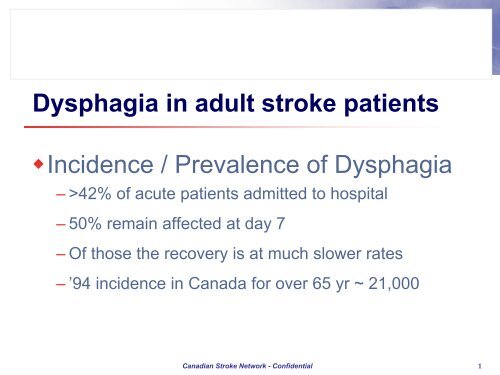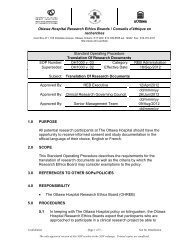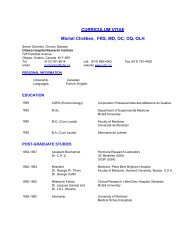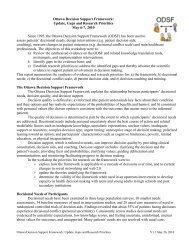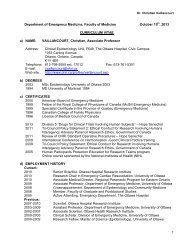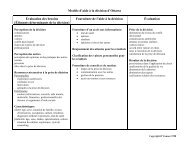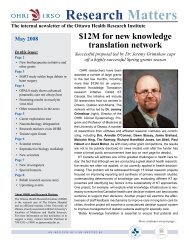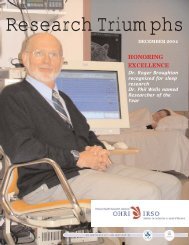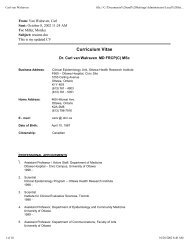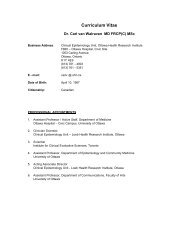Dysphagia in adult stroke patients Incidence / Prevalence of ...
Dysphagia in adult stroke patients Incidence / Prevalence of ...
Dysphagia in adult stroke patients Incidence / Prevalence of ...
- No tags were found...
Create successful ePaper yourself
Turn your PDF publications into a flip-book with our unique Google optimized e-Paper software.
<strong>Dysphagia</strong> <strong>in</strong> <strong>adult</strong> <strong>stroke</strong> <strong>patients</strong>•<strong>Incidence</strong> / <strong>Prevalence</strong> <strong>of</strong> <strong>Dysphagia</strong>– >42% <strong>of</strong> acute <strong>patients</strong> admitted to hospital– 50% rema<strong>in</strong> affected at day 7– Of those the recovery is at much slower rates– ’94 <strong>in</strong>cidence <strong>in</strong> Canada for over 65 yr ~ 21,000Canadian Stroke Network - Confidential 1
<strong>Dysphagia</strong> <strong>in</strong> <strong>adult</strong> <strong>stroke</strong> <strong>patients</strong>‘Estimated’ recovery <strong>of</strong> dysphagia follow<strong>in</strong>g <strong>stroke</strong>6050403020% <strong>Dysphagia</strong> +100Acute 1 mo 2 mo 3moCanadian Stroke Network - Confidential 2
<strong>Dysphagia</strong> <strong>in</strong> <strong>adult</strong> <strong>stroke</strong> <strong>patients</strong>• Significance <strong>of</strong> dysphagia <strong>in</strong> <strong>stroke</strong>• Malnutrition• Dehydration• Aspiration Pneumonia• LOS• MortalityCanadian Stroke Network - Confidential 3
<strong>Dysphagia</strong> screen<strong>in</strong>g <strong>in</strong> <strong>stroke</strong> <strong>patients</strong>• Does early detection alter healthoutcomes?• Do bedside screen<strong>in</strong>g maneuversaccurately detect dysphagia asdef<strong>in</strong>ed by vide<strong>of</strong>luoroscopy?Mart<strong>in</strong>o, et al (2000) <strong>Dysphagia</strong>:15;19-30Canadian Stroke Network - Confidential 4
INCLUDEScreen<strong>in</strong>g for <strong>Dysphagia</strong>:Where We Are?EXCLUDEGood evidence forconsideration <strong>of</strong> thescreen<strong>in</strong>g maneuver.Fair evidence forconsideration <strong>of</strong> thescreen<strong>in</strong>g maneuver.ABDEGood evidence forexclusion <strong>of</strong> thescreen<strong>in</strong>g maneuver.Fair evidence forexclusion <strong>of</strong> thescreen<strong>in</strong>g maneuver.CPoor evidence for <strong>in</strong>clusion or exclusion, butrecommendations may be made on other grounds.Canadian Stroke Network - Confidential 5
TOR-BSST research• Objectives1 <strong>Dysphagia</strong> on screen<strong>in</strong>g (TOR-BSST) will positivelyrelate to AbN swallow<strong>in</strong>g on VFS2 TOR-BSST will be reliable3 TOR-BSST can measure prevalence <strong>of</strong> dysphagia<strong>in</strong> <strong>stroke</strong> & mark its natural Hx across thecont<strong>in</strong>uum <strong>of</strong> careCanadian Stroke Network - Confidential 7
Does Detection and Treatment <strong>of</strong> <strong>Dysphagia</strong><strong>in</strong> Stroke Patients Alter Their Outcome?Applyscreen<strong>in</strong>gto <strong>stroke</strong><strong>patients</strong>Detecthighprobability<strong>of</strong>dysphagiaEarlierdiagnosticwork-upwith possibleVFSChange <strong>in</strong>choice ortim<strong>in</strong>g <strong>of</strong>TreatmentChange <strong>in</strong>Health O/C:• Pneumonia• Malnutrition• Dehydration• MortalityDetection Treatment OutcomeAdopted from Eddy, 1991Canadian Stroke Network - Confidential 8
As <strong>of</strong> Sept 2004……Target Jan 2005255 <strong>patients</strong> enrolled across 4 sites to dateRehab enrollment completedAcute enrollment beh<strong>in</strong>d target• Admits to general neuro (vs. <strong>stroke</strong>) units (16%)• Low NIH Scores (10%)• Hx <strong>of</strong> <strong>stroke</strong> that did not affect swallow<strong>in</strong>g (16%)Canadian Stroke Network - Confidential 9
Heart and Stroke Foundation <strong>of</strong> Ontario & Ontario M<strong>in</strong>istry <strong>of</strong> HealthA Regional Approach to <strong>Dysphagia</strong>ManagementParticipat<strong>in</strong>g Regions <strong>in</strong> Southern Ontario (2)Kitchener/WaterlooNiagara Pen<strong>in</strong>sulaParticipat<strong>in</strong>g Institutions with<strong>in</strong> these Regions (9)Canadian Stroke Network - Confidential 10
Best Practice Guidel<strong>in</strong>es forManag<strong>in</strong>g <strong>Dysphagia</strong>• Improv<strong>in</strong>g the management <strong>of</strong> dysphagia <strong>in</strong> <strong>stroke</strong> necessitates an<strong>in</strong>novative use <strong>of</strong> regional resources• Ontario has a shortage <strong>of</strong> SLPs• With their specialized tra<strong>in</strong><strong>in</strong>g, SLPs are key to recognize, assessand manage swallow<strong>in</strong>g• Each hospital develops an <strong>in</strong>terdiscipl<strong>in</strong>ary swallow<strong>in</strong>g team (withMD, RN, OT, PT &/or RD) with support from a regional SLP• Swallow<strong>in</strong>g team tra<strong>in</strong>ed to provide screen<strong>in</strong>g <strong>of</strong> all acute <strong>stroke</strong><strong>patients</strong>, therefore identify<strong>in</strong>g dysphagia riskCanadian Stroke Network - Confidential 11
<strong>Dysphagia</strong> Screen<strong>in</strong>g Model: ARegional Pilot ProjectPhase ADevelopment and ImplementationPhase BAssessment with<strong>in</strong> the Acute Sett<strong>in</strong>gPhase CFeasibility with<strong>in</strong> the Acute & RehabCanadian Stroke Network - Confidential 12
<strong>Dysphagia</strong> Screen<strong>in</strong>g Model: ARegional Pilot ProjectResults√ Decreased variation <strong>in</strong> practice with new program√ Increased theoretical knowledge <strong>in</strong> those tra<strong>in</strong>ed√ Increased satisfaction <strong>in</strong> those tra<strong>in</strong>ed? Improved QOL <strong>in</strong> <strong>stroke</strong> <strong>patients</strong>? Improved satisfaction <strong>in</strong> <strong>stroke</strong> <strong>patients</strong>Canadian Stroke Network - Confidential 13
<strong>Dysphagia</strong> Screen<strong>in</strong>g Model: ARegional Pilot ProjectThreats• SLPs concerned that new program might detract appropriatedysphagia referrals to SLP• SLPs concerned that tra<strong>in</strong>ed pr<strong>of</strong>essionals would not understand thedifference between screen<strong>in</strong>g and assessment• Facilities reluctant to abandon exist<strong>in</strong>g service delivery models• Large geographic distances between hospitals with<strong>in</strong> the same regionlimited the frequency <strong>of</strong> on-site visits from the regional studycoord<strong>in</strong>atorCanadian Stroke Network - Confidential 14
The Overall Screen<strong>in</strong>g Question:Does Detection and Treatment <strong>of</strong> <strong>Dysphagia</strong><strong>in</strong> Stroke Patients Alter Their Outcome?Applyscreen<strong>in</strong>gto <strong>stroke</strong><strong>patients</strong>Detecthighprobability<strong>of</strong>dysphagiaEarlierdiagnosticwork-upwith possibleVFSChange <strong>in</strong>choice ortim<strong>in</strong>g <strong>of</strong>TreatmentChange <strong>in</strong>Health O/C:• pneumonia• malnutrition• dehydration• mortalityDirect Evidence : Evidence directly supports screen<strong>in</strong>g effects on healthoutcomes.In-Direct Evidence: Evidence for separate l<strong>in</strong>ks <strong>in</strong> the cha<strong>in</strong> suggest butare not confirmatory that screen<strong>in</strong>g improves healthoutcomes.Adopted from Eddy, 1991Canadian Stroke Network - Confidential 15


